|
Battle of Shiloh
Second Day of Battle
| Young Confederate enlisted men |
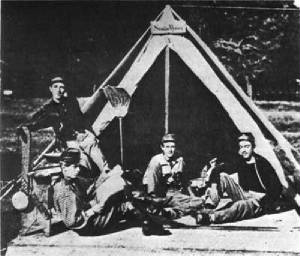
|
| (Battle of Shiloh) |
Young Confederate enlisted men from the Washington
Artillery of New Orleans.
From a photograph made prior to the Battle of Shiloh.
Monday morning, April 7, at daylight, the vanquished of the previous day renewed the struggle with increased
strength and restored confidence. Anxious to take the initiative the Union armies were put in motion almost simultaneously,
with Buell on the left, Lew Wallace on the extreme right, and Grant's weary troops occupying the space between. The movement
began unopposed, except by small unsupported parties which were quickly forced to retreat.
| Civil War Battle of Shiloh Second Day Map |
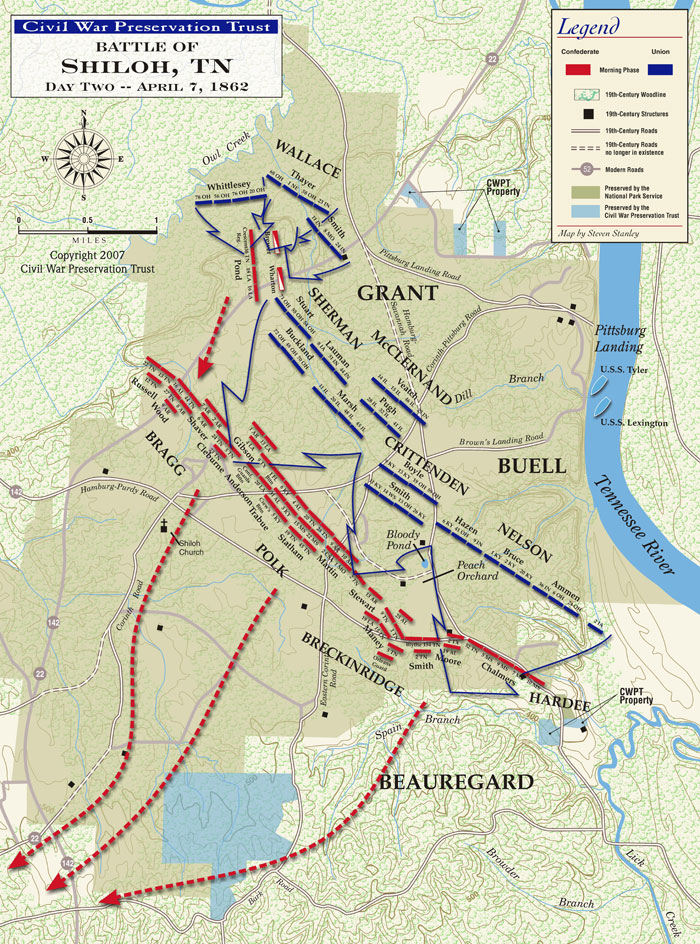
|
| Shiloh Civil War Map, Courtesy Civil War Trust |
The Confederates had been unable to reorganize their widely
scattered forces during the night. Therefore, when the Union advance began on Monday the opposing line of battle was yet unformed.
The Confederates were still back in the vicinity of the captured Union camps vainly trying to reorganize their broken commands.
They did not succeed in forming a line until after the enemy had advanced beyond the Peach Orchard and the Hornets' Nest,
regaining much of the territory they had lost the day before.
The Confederates, one brigade strong, were first encountered
by Lew Wallace a short distance in front of his Sunday night bivouac. In a brief but spirited engagement, the Confederates
were attacked in front and on the left flank by the Union division. To keep from being surrounded, they fell back almost a
mile in the direction of Shiloh Church to take their place in the forming line of battle.
| Arrival of Federal reinforcements. |
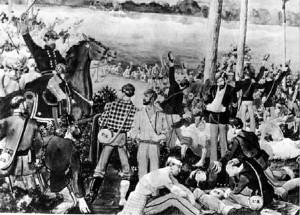
|
| (Battle of Shiloh) |
Arrival of Federal reinforcements.
In the meantime, Buell moved his troops rapidly forward until
they developed the Confederate line of battle west of the Peach Orchard. The Southerners boldly charged the advancing Union
infantry which had moved forward so rapidly that its artillery was still far to the rear. With out artillery support, the
Federals were unable to withstand the violent assault of the Confederates and were forced to make a hasty retreat. The timely
arrival and effective use of two batteries of artillery permitted the Union line again to advance, only to be driven back
once more by the stubborn Confederates.
The battle now raged the entire length of the field. Charge
followed by countercharge moved the fitfully swaying line first toward the river and then toward the church. The advantage
would seem to test momentarily with the weary Southerners, but would soon be lost to their greatly strengthened opponent.
Commands became so intermingled and confused that it was often impossible to distinguish between friend and foe. The Confederates,
clad in a variety of colored uniforms, with no well-defined line and on an ever-changing front, suffered the heavier losses
from the fire of their own troops.
| First Civil War field hospital |
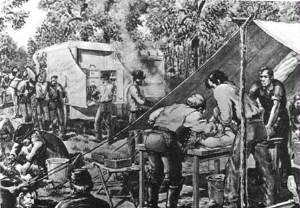
|
| (Battle of Shiloh) |
The first tent field hospital ever used for the
treatment of the wounded on the battlefield was established at Shiloh, April 7, 1862.
Meanwhile, General Beauregard, at Shiloh Church, anxiously awaited
the return of couriers he had dispatched to Corinth to hurry forward Gen. Earl Van Dorn's army of about 20,000 men, daily
expected there from Van Buren, Ark. He had promised to make a junction with General Beauregard as soon as possible, but was
delayed because he had no means of transporting his troops across the Mississippi. Unaware that Van Dorn was still in Arkansas,
General Beauregard maintained his largest troop concentration in the vicinity of the church to defend the Corinth-Pittsburg
Road so that reinforcements could be quickly moved onto the field. As soon as it became known that additional troops were
not on the way, Beauregard realized that the road would have to be kept open as a possible line of retreat. The Union commanders
were equally determined to drive the Confederates from the position. Consequently, furious fighting raged before the church
long after the tempo of the battle had slackened on each flank.
Despite all efforts of the Confederates, the Union line continued
slowly to advance. In desperation the Confederates made a gallant charge, first expending their ammunition and then relying
on the bayonet. The charge carried the surging line through waist-deep Water Oaks Pond, beyond which the fire from the adversary
became so strong that the line was brought to an abrupt halt. Taking cover at the edge of a woods, they repulsed every attempt
by the Federals to advance.
By 2 p. m. General Beauregard decided it was useless to prolong
the unequal struggle. Since early morning, his lines had been forced back, step by step, with heavy losses. From all parts
of the field his subordinates were sending urgent requests for reinforcements, which he was unable to supply. Even his position
at the church was in danger of being taken. A continuation of the battle could bring only additional disasters upon his already
greatly depleted ranks. To forestall a complete rout, he ordered a rear guard with artillery support to be put in position
on the ridge west of the church and instructed his corps commanders to begin withdrawing their troops. By 4 o'clock, the last
of the Confederate Army, or what was left of it, had retired from the field and was leisurely making its way back to Corinth
without a single Federal soldier in pursuit.
| How the Battle of Shiloh was Fought |
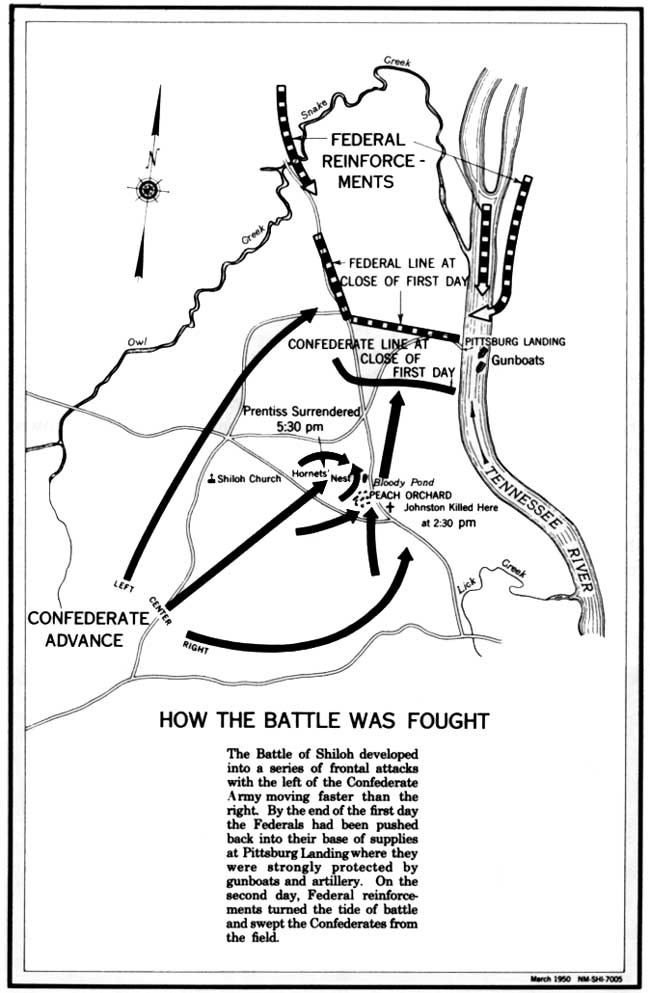
|
| Battle of Shiloh Battlefield Map |
How the Battle was Fought.
The Union armies did not attempt to harass the retreating Southern
columns or attack them when they went into bivouac for the night. Instead, Grant's troops, from the privates to the highest
commanders, appear to have been content to return to their recaptured camps, while the Confederates returned to their former
positions in and around Corinth to recruit and reorganize.
In explanation of his inactivity Grant said: "My force was too
much fatigued from two days' hard fighting and exposure in the open air to a drenching rain during the intervening night,
to pursue immediately. Night closed in cloudy and with heavy rain, making roads impracticable for artillery by the next morning."
The next morning, April 8, however, Gen. Thomas J. Wood, with
his division, and Sherman, with two brigades and the 4th Illinois Cavalry, went in pursuit. Toward evening they came upon
the Confederate rear guard at Fallen Timbers, about 6 miles from the battlefield. The Southern cavalry, commanded by Col.
Nathan Bedford Forrest, charged the Federals, putting the skirmishers to flight and throwing the Union cavalry into confusion.
The Confederates, pursuing too vigorously, came suddenly upon the main body of Federal infantry and were repulsed, after Colonel
Forrest had been seriously wounded in the side. Before returning to camp, the Northerners tarried long enough to bury their
15 dead, gather up their 25 wounded, and find out that they had lost 75 as prisoners. The spirited action of the Confederate
rear guard at Fallen Timbers put an end to all ideas of further pursuit by the Federals.
(Sources listed at bottom of page.)
Recommended
Reading:
Shiloh and the Western Campaign of 1862. Review: The bloody and decisive two-day battle of Shiloh (April
6-7, 1862) changed the entire course of the American Civil War. The stunning Northern victory thrust Union commander Ulysses
S. Grant into the national spotlight, claimed the life of Confederate commander Albert S. Johnston, and forever buried the
notion that the Civil War would be a short conflict. The conflagration at Shiloh had its roots in the strong Union advance
during the winter of 1861-1862 that resulted in the capture of Forts Henry and Donelson in Tennessee. Continued below…
The offensive
collapsed General Albert S. Johnston advanced line in Kentucky and forced him to withdraw all the way to northern Mississippi. Anxious to attack the enemy, Johnston began
concentrating Southern forces at Corinth, a major railroad center just below the Tennessee border. His bold plan called for his Army of the Mississippi to march north and destroy General Grant's Army of the Tennessee
before it could link up with another Union army on the way to join him. On the morning of April 6, Johnston
boasted to his subordinates, "Tonight we will water our horses in the Tennessee!"
They nearly did so. Johnston's sweeping attack hit the unsuspecting Federal camps at Pittsburg
Landing and routed the enemy from position after position as they fell back toward the Tennessee River.
Johnston's sudden death in the Peach Orchard, however, coupled
with stubborn Federal resistance, widespread confusion, and Grant's dogged determination to hold the field, saved the Union
army from destruction. The arrival of General Don C. Buell's reinforcements that night turned the tide of battle. The next
day, Grant seized the initiative and attacked the Confederates, driving them from the field. Shiloh
was one of the bloodiest battles of the entire war, with nearly 24,000 men killed, wounded, and missing. Edward Cunningham,
a young Ph.D. candidate studying under the legendary T. Harry Williams at Louisiana
State University, researched and wrote Shiloh and the Western Campaign of 1862 in 1966. Although it remained unpublished, many Shiloh
experts and park rangers consider it to be the best overall examination of the battle ever written. Indeed, Shiloh
historiography is just now catching up with Cunningham, who was decades ahead of modern scholarship. Western Civil War historians
Gary D. Joiner and Timothy B. Smith have resurrected Cunningham's beautifully written and deeply researched manuscript from
its undeserved obscurity. Fully edited and richly annotated with updated citations and observations, original maps, and a
complete order of battle and table of losses, Shiloh and the Western Campaign of 1862 will
be welcomed by everyone who enjoys battle history at its finest. Edward Cunningham, Ph.D., studied under T. Harry Williams
at Louisiana State
University. He was the author of The Port Hudson Campaign: 1862-1863
(LSU, 1963). Dr. Cunningham died in 1997. Gary D. Joiner, Ph.D. is the author of One Damn Blunder from Beginning to End: The
Red River Campaign of 1864, winner of the 2004 Albert Castel Award and the 2005 A. M. Pate, Jr., Award, and Through the Howling
Wilderness: The 1864 Red River Campaign and Union Failure in the West. He lives in Shreveport,
Louisiana. About the Author: Timothy B. Smith, Ph.D., is author of Champion Hill:
Decisive Battle for Vicksburg (winner of the 2004 Mississippi
Institute of Arts and Letters Non-fiction Award), The Untold Story of Shiloh: The Battle and the Battlefield, and This Great
Battlefield of Shiloh: History, Memory, and the Establishment of a Civil War National Military Park. A former ranger at Shiloh,
Tim teaches history at the University of Tennessee.
Recommended
Reading: Shiloh: The Battle
That Changed the Civil War (Simon & Schuster).
From Publishers Weekly: The bloodbath at Shiloh, Tenn.
(April 6-7, 1862), brought an end to any remaining innocence in the Civil War. The combined 23,000 casualties that the two
armies inflicted on each other in two days shocked North and South alike. Ulysses S. Grant kept his head and managed, with
reinforcements, to win a hard-fought victory. Continued below…
Confederate
general Albert Sidney Johnston was wounded and bled to death, leaving P.G.T. Beauregard to disengage and retreat with a dispirited
gray-clad army. Daniel (Soldiering in the Army of Tennessee) has crafted a superbly researched volume that will appeal to
both the beginning Civil War reader as well as those already familiar with the course of fighting in the wooded terrain bordering
the Tennessee River.
His impressive research includes the judicious use of contemporary newspapers and extensive collections of unpublished letters
and diaries. He offers a lengthy discussion of the overall strategic situation that preceded the battle, a survey of the generals
and their armies and, within the notes, sharp analyses of the many controversies that Shiloh
has spawned, including assessments of previous scholarship on the battle. This first new book on Shiloh
in a generation concludes with a cogent chapter on the consequences of those two fatal days of conflict.
Recommended
Reading: Shiloh--In Hell before Night. Description: James McDonough has written a good, readable and concise history of
a battle that the author characterizes as one of the most important of the Civil War, and writes an interesting history of
this decisive 1862 confrontation in the West. He blends first person and newspaper accounts to give the book a good balance
between the general's view and the soldier's view of the battle. Continued below…
Particularly
enlightening is his description of Confederate General Albert Sidney Johnston, the commander who was killed on the first day
of the battle. McDonough makes a pretty convincing argument that Johnston fell far short of the image that many give him
in contemporary and historical writings. He is usually portrayed as an experienced and decisive commander of men. This book
shows that Johnston was a man of modest war and command experience,
and that he rose to prominence shortly before the Civil War. His actions (or inaction) prior to the meeting at Shiloh -- offering
to let his subordinate Beauregard take command for example -- reveal a man who had difficulty managing the responsibility
fostered on him by his command. The author does a good job of presenting several other historical questions and problems like
Johnston's reputation vs. reality that really add a lot of
interest to the pages.
Recommended
Reading: Seeing the Elephant: RAW RECRUITS AT THE BATTLE
OF SHILOH.
Description: One of the bloodiest battles in the Civil War, the two-day engagement near Shiloh,
Tennessee, in April 1862 left more than 23,000 casualties. Fighting alongside
seasoned veterans were more than 160 newly recruited regiments and other soldiers who had yet to encounter serious action.
In the phrase of the time, these men came to Shiloh to "see the elephant". Continued below…
Drawing on
the letters, diaries, and other reminiscences of these raw recruits on both sides of the conflict, "Seeing the Elephant" gives
a vivid and valuable primary account of the terrible struggle. From the wide range of voices included in this volume emerges
a nuanced picture of the psychology and motivations of the novice soldiers and the ways in which their attitudes toward the
war were affected by their experiences at Shiloh.
Recommended
Reading: Shiloh: A Novel, by Shelby Foote. Review: In the novel Shiloh, historian and Civil
War expert Shelby Foote delivers a spare, unflinching account of the battle of Shiloh, which
was fought over the course of two days in April 1862. By mirroring the troops' movements through the woods of Tennessee with the activity of each soldier's mind, Foote offers the reader a broad perspective
of the battle and a detailed view of the issues behind it. Continued below…
The battle
becomes tangible as Foote interweaves the observations of Union and Confederate officers, simple foot soldiers, brave men, and cowards and describes
the roar of the muskets and the haze of the gun smoke. The author's vivid storytelling creates a rich chronicle of a pivotal
battle in American history.
Recommended Reading: The Battle
of Shiloh and the Organizations Engaged (Hardcover). Description: How can an essential "cornerstone of Shiloh
historiography" remain unavailable to the general public for so long? That's what I kept thinking as I was reading this reprint
of the 1913 edition of David W. Reed's “The Battle of Shiloh and the Organizations Engaged.” Reed, a veteran of
the Battle of Shiloh and the first historian of the Shiloh National Military Park,
was tabbed to write the official history of the battle, and this book was the result. Reed wrote a short, concise history
of the fighting and included quite a bit of other valuable information in the pages that followed. The large and impressive
maps that accompanied the original text are here converted into digital format and included in a CD located within a flap
at the back of the book. Author and former Shiloh Park Ranger Timothy Smith is responsible for bringing this important reference
work back from obscurity. His introduction to the book also places it in the proper historical framework. Continued below…
Reed's history of the campaign and battle covers only seventeen pages and is meant to be a brief history of the subject.
The detail is revealed in the rest of the book. And what detail there is! Reed's order of battle for Shiloh goes down to the regimental
and battery level. He includes the names of the leaders of each organization where known, including whether or not these men
were killed, wounded, captured, or suffered some other fate. In a touch not often seen in modern studies, the author also
states the original regiment of brigade commanders. In another nice piece of detail following the order of battle, staff officers
for each brigade and higher organization are listed. The book's main point and where it truly shines is in the section entitled
"Detailed Movements of Organizations". Reed follows each unit in their movements during the battle. Reading this section along
with referring to the computerized maps gives one a solid foundation for future study of Shiloh.
Forty-five pages cover the brigades of all three armies present at Shiloh.
Wargamers and buffs will love the "Abstract of Field Returns". This section lists Present for Duty, engaged, and casualties
for each regiment and battery in an easy to read table format. Grant's entire Army of the Tennessee has Present for Duty strengths. Buell's Army of the Ohio is also counted well. The Confederate Army of the Mississippi
is counted less accurately, usually only going down to brigade level and many times relying only on engaged strengths. That
said, buy this book if you are looking for a good reference work for help with your order of battle.
In what I believe is an unprecedented move in Civil War literature, the University
of Tennessee Press made the somewhat unusual decision to include Reed's
detailed maps of the campaign and battle in a CD which is included in a plastic sleeve inside the back cover of the book.
The cost of reproducing the large maps and including them as foldouts or in a pocket in the book must have been prohibitive,
necessitating this interesting use of a CD. The maps were simple to view and came in a PDF format. All you'll need is Adobe
Acrobat Reader, a free program, to view these. It will be interesting to see if other publishers follow suit. Maps are an
integral part of military history, and this solution is far better than deciding to include poor maps or no maps at all. The
Read Me file that came with the CD relays the following information:
-----
The maps contained on this CD are scans of the original oversized maps printed in the 1913 edition of D. W. Reed's
The Battle of Shiloh and the Organizations Engaged. The original maps, which were in a very large format and folded out of
the pages of this edition, are of varying sizes, up to 23 inches by 25 inches. They were originally created in 1901 by the
Shiloh National Military Park under the direction of its historian,
David W. Reed. They are the most accurate Shiloh battle maps in existence.
The maps on the CD are saved as PDF (Portable Document Format) files and can be read on any operating system (Windows,
Macintosh, Linux) by utilizing Adobe Acrobat Reader. Visit http://www.adobe.com to download Acrobat Reader if you do not have
it installed on your system.
Map 1. The Field of Operations from Which the Armies Were Concentrated at Shiloh,
March and April 1862
Map 2. The Territory between Corinth, Miss., and Pittsburgh Landing, Tenn., Showing Positions and Route of the Confederate
Army in Its Advance to Shiloh, April 3, 4, 5, & 6, 1862
Map 3. Positions on the First Day, April 6, 1862
Map 4. Positions on the Second Day, April 7, 1862
Complete captions appear on the maps.
-----
Timothy Smith has done students of the Civil War an enormous favor by republishing this important early work on Shiloh. Relied on for generations by Park Rangers and other serious students of the battle, The Battle
of Shiloh and the Organizations Engaged has been resurrected for a new generation of Civil War readers. This classic reference
work is an essential book for those interested in the Battle of Shiloh. Civil War buffs, wargamers, and those interested in
tactical minutiae will also find Reed's work to be a very good buy. Highly recommended.
Sources: Albert Dillahunty, Shiloh National Military Park Tennessee: National Park Service Historical Handbook
Series No. 10, Washington, D.C., 1955. Reprint 1961; National Park Service; Civil War Preservation Trust.
|

